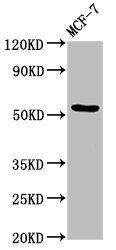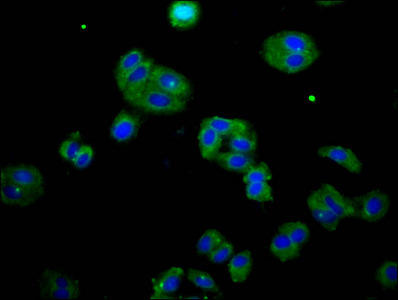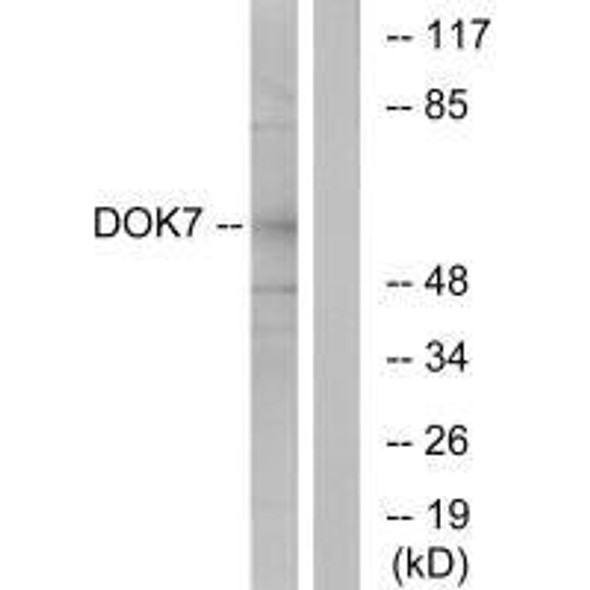Description
DOK7 Antibody (PACO56398)
The DOK7 Monoclonal Antibody (PAC056398) is a vital tool for researchers studying DOK7, a protein involved in various cellular processes, particularly in the regulation of muscle development and function. This antibody, produced through monoclonal technology, exhibits high specificity and sensitivity towards DOK7 in human samples, making it ideal for applications such as immunofluorescence and flow cytometry.DOK7 is a crucial regulator of the neuromuscular junction, playing a significant role in the formation and maintenance of muscle function.
Dysregulation of DOK7 has been implicated in various neuromuscular disorders and myasthenia gravis, highlighting its importance in muscle-related pathologies. By targeting DOK7 with this specific antibody, researchers can delve deeper into understanding its role in muscle biology and potentially uncover novel therapeutic targets for muscle-related diseases.
| Antibody Name: | DOK7 Antibody (PACO56398) |
| Antibody SKU: | PACO56398 |
| Size: | 50ug |
| Host Species: | Rabbit |
| Tested Applications: | ELISA, WB, IF |
| Recommended Dilutions: | ELISA:1:2000-1:10000, WB:1:500-1:5000, IF:1:50-1:200 |
| Species Reactivity: | Human |
| Immunogen: | Recombinant Human Protein Dok-7 protein (416-504AA) |
| Form: | Liquid |
| Storage Buffer: | Preservative: 0.03% Proclin 300 Constituents: 50% Glycerol, 0.01M PBS, pH 7.4 |
| Purification Method: | >95%, Protein G purified |
| Clonality: | Polyclonal |
| Isotype: | IgG |
| Conjugate: | Non-conjugated |
 | Western Blot. Positive WB detected in: MCF-7 whole cell lysate. All lanes: DOK7 antibody at 4.9µg/ml. Secondary. Goat polyclonal to rabbit IgG at 1/50000 dilution. Predicted band size: 54, 38, 28, 64 kDa. Observed band size: 54 kDa. |
 | Immunofluorescence staining of HepG2 cells with PACO56398 at 1:133, counter-stained with DAPI. The cells were fixed in 4% formaldehyde, permeabilized using 0.2% Triton X-100 and blocked in 10% normal Goat Serum. The cells were then incubated with the antibody overnight at 4°C. The secondary antibody was Alexa Fluor 488-congugated AffiniPure Goat Anti-Rabbit IgG(H+L). |
| Background: | Probable muscle-intrinsic activator of MUSK that plays an essential role in neuromuscular synaptogenesis. Acts in aneural activation of MUSK and subsequent acetylcholine receptor (AchR) clustering in myotubes. Induces autophosphorylation of MUSK. |
| Synonyms: | Protein Dok-7 (Downstream of tyrosine kinase 7), DOK7, C4orf25 |
| UniProt Protein Function: | DOK7: docking proteins are enzymatically inert adaptor or scaffolding proteins. They provide a docking platform for the assembly of multimolecular signaling complexes. Probable muscle-intrinsic activator of MUSK that plays an essential role in neuromuscular synaptogenesis. Acts in aneural activation of MUSK and subsequent acetylcholine receptor (AchR) clustering in myotubes. Induces autophosphorylation of MUSK. Interacts with the cytoplasmic part of MUSK. Defects in DOK7 are the cause of congenital myasthenic syndrome type 1B or CMS1B. Three isoforms of the human protein are produced by alternative splicing. |
| UniProt Protein Details: | Protein type:Adaptor/scaffold; Activator Chromosomal Location of Human Ortholog: 4p16.3 Cellular Component: cell junction; plasma membrane; synapse Molecular Function:insulin receptor binding; lipid binding; protein kinase binding Disease: Fetal Akinesia Deformation Sequence; Myasthenia, Limb-girdle, Familial |
| NCBI Summary: | The protein encoded by this gene is essential for neuromuscular synaptogenesis. The protein functions in aneural activation of muscle-specific receptor kinase, which is required for postsynaptic differentiation, and in the subsequent clustering of the acetylcholine receptor in myotubes. This protein can also induce autophosphorylation of muscle-specific receptor kinase. Mutations in this gene are a cause of familial limb-girdle myasthenia autosomal recessive, which is also known as congenital myasthenic syndrome type 1B. Alternative splicing results in multiple transcript variants. [provided by RefSeq, Sep 2009] |
| UniProt Code: | Q18PE1 |
| NCBI GenInfo Identifier: | 115311705 |
| NCBI Gene ID: | 285489 |
| NCBI Accession: | Q18PE1.1 |
| UniProt Secondary Accession: | Q18PE1,Q6P6A6, Q86XG5, Q8N2J3, Q8NBC1, A2A499, A2RRD4 E9PB56, |
| UniProt Related Accession: | Q18PE1 |
| Molecular Weight: | 63,938 Da |
| NCBI Full Name: | Protein Dok-7 |
| NCBI Synonym Full Names: | docking protein 7 |
| NCBI Official Symbol: | DOK7 |
| NCBI Official Synonym Symbols: | CMS10; CMS1B; C4orf25 |
| NCBI Protein Information: | protein Dok-7 |
| UniProt Protein Name: | Protein Dok-7 |
| UniProt Synonym Protein Names: | Downstream of tyrosine kinase 7 |
| Protein Family: | Protein |
| UniProt Gene Name: | DOK7 |
| UniProt Entry Name: | DOK7_HUMAN |
| Antibodies | ELISA Kits |
| DOK7 Antibody (PACO03946) | DOK7 Colorimetric Cell-Based ELISA |
| Secondary Antibody |
| Anti-HRP Goat Anti-Rabbit IgG (H+L) Antibody (CABS014) |
| Recommended Products |
| Anti-FITC Goat Anti-Rabbit IgG (H+L) Antibody (CABS011) |
| Anti-HRP-conjugated Beta Actin Antibody (CABC028) |













